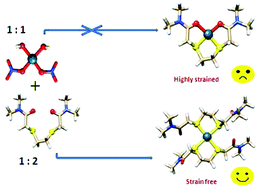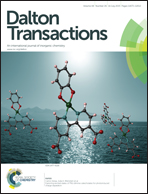Synthesis, structural and theoretical studies of dithiodiglycolamide compounds of palladium(ii)†
Abstract
The reaction of palladium(II) halide with dithiodiglycolamide ligands yielded compounds of the type [PdX2L] (where X = Cl, L = (CH2SCH2CONiPr2)2 (1); L = (CH2SCH2CONiBu2)2 (2); L = (CH2SCH2CONBu2)2 (3); L = C7H6(SCH2CONiBu2)2 (4); X = Br, L = (CH2SCH2CONiBu2)2 (5); X = I, L = (CH2SCH2CONiBu2)2 (6)), whereas palladium(II) nitrate yielded compounds of the type [PdL2](NO3)2 (where L = (CH2SCH2CONiPr2)2 (7); L = (CH2SCH2CONiBu2)2 (8)). All compounds were characterized by using IR, 1H NMR spectral techniques and CHN analyses. The structures of compounds 4, 5 and 7 have been determined by using X-ray diffraction methods. The structures show that the ligands bond through the thioether group to the metal centre in all compounds. They show further that the palladium(II) ion is surrounded by four atoms (two halogens and two thio groups in 4 and 5 and four thio groups in 7) in a square planar arrangement. The dithiodiglycolamide ligand acts as a bidentate chelating ligand and bonds through both the thioether groups to the metal centre, leaving the carbamoyl groups uncoordinated. Theoretical studies reveal that the 1 : 2 compound is energetically more stable and nicely correlates with the IR carbamoyl stretching frequencies as compared to the 1 : 1 compound in which the ligand acts as a tetradentate ligand.


 Please wait while we load your content...
Please wait while we load your content...